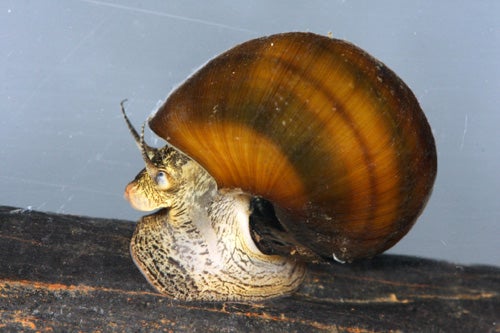Common Name: Anthony's Riversnail
Scientific Name: Athearnia anthonyi (Redfield)
Other Names: none
Size: 25 mm [1 in.]
Description: Shell thick and ponderous (max. length = approx. 25 mm [1 in.]), ovate in outline, with a short spire, although whorls above body whorl often badly eroded. Body whorl flat to slightly convex and strongly shouldered, usually with series of large, irregular, obtuse tubercles that often appear as little more than undulations of shoulder. Shell aperture ovate, with a thin basal lip, often showing some purple coloration within. Basal lip reflected to partially or completely cover umbilical area. Periostracum of shell yellowish green to dark brown, usually darkening with age. Purplish or brownish bands often encircle body whorl, becoming indistinct as shell darkens. Juveniles distinct, being as wide as long, with a pointed spire and basal lip and strong carina around body whorl producing a saucer-shaped outline. Carina gradually disappears with age. (Modified from Tryon 1873, USFWS 1996).
Distribution: Historically occurred in Tennessee River from Knoxville, Tennessee, downstream to Muscle Shoals, extending into some large and medium tributaries. Only two populations known to be extant. One population in a short reach of Tennessee River proper, from just upstream of mouth of Sequatchie River at Tennessee River Mile (TRM) 423, Marion County, Tennessee, to just downstream of Bridgeport Island (TRM 411), Jackson County, Alabama. This population extends up Sequatchie River for at least several miles (USFWS 1996). Other population located in lower Limestone Creek, Limestone County, Alabama, extending from just above impounded mouth at Limestone Creek Mile (LCM) 4 upstream to LCM 13.
Habitat: Typically in lotic areas, but occasionally found in pools adjacent to shoals. Main stem Tennessee River population located in water three to four meters (13 feet) deep in riverine habitat downstream of Nickajack Dam. Preferred substrata vary from gravel to boulders. Often found on submerged woody debris and aquatic vegetation in and around lotic habitats.
Life History and Ecology: New recruits into Limestone Creek population appear in May. Little else known.
Basis for Status Classification: Vulnerable to extinction due to specialized habitat requirements and declining population trend. Eliminated from majority of distribution when Tennessee River impounded, destroying most of habitat in main stem and isolated fragments of population in tributaries. Other poor land use practices probably played role in decline of species in tributaries. Listed as endangered in Alabama (Stein 1976). Listed as endangered by the U.S. Fish and Wildlife Service in 1994. In 2001, included in list of species approved for a Nonessential Experimental Population in riverine reach of Tennessee River, downstream of Wilson Dam. A federal permit is in place to transplant 4,000 individuals from Limestone Creek population in spring 2003.







